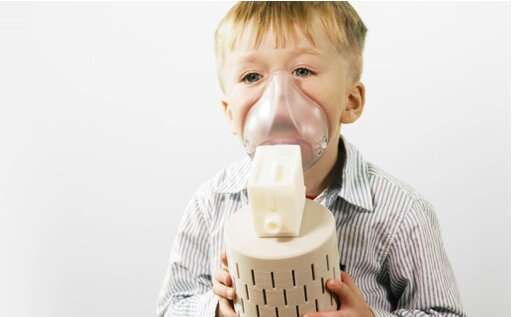Innovative breath sampling device could revolutionize diagnosis of diseases, including COVID-19

New research shows 100% effectiveness of an innovative breath sampling device developed by Northumbria University medtech spinout, PulmoBioMed, that could revolutionize diagnosis of a range of diseases, including COVID-19.
The results mean that PulmoBioMed's game-changing device, PBM-HALE, can be used to study infections of the deep lung, reducing the need for invasive or costly procedures often required for disease diagnosis.
PBM-Hale is a hand-held aerosol collecting device that allows sampling of the lung in a non-invasive way—by patients simply breathing into it.
To date, all inventions used for collecting breath samples are challenged by issues relating to contamination, sample loss and variability. PBM-Hale technology resolves these issues, with newly published data showing that the device detected 100% of COVID-19 cases tested in the company's latest clinical study.
Dr. Sterghios Moschos, Associate Professor at Northumbria University and Founder and Chief Scientific Officer of PulmoBioMed, said, "We and others have now shown with various devices that exhaled breath contains the virus that causes COVID-19. Previous studies though could not distinguish between what is coming out of the mouth (saliva) and what comes out in fine aerosol particles. Some of them were also very easy to contaminate with virus in the atmosphere or the skin.
"Our study is the first to show that the virus can be detected in the fine aerosol particles generated in the lung, even in resting breath. It shows the virus is found mostly in the tiniest particles we breathe out, not the saliva that might be accidentally spit out as we breathe or speak.
"This means that using our device in combination with the standard PCR test used worldwide, we can detect the genome of the virus in 100% of patients, when sampling the breath for just one minute. This would identify anyone infectious or shedding virus.
"We are also the first to show that the amount of virus produced is 90 times higher on average if you sing loudly. It reinforces why high-quality masks are important to prevent transmission indoors, and why ventilating enclosed spaces is critical to preventing transmission. These small particles are known to linger for hours if the space is not ventilated.
"The study shows that PBM-HALE can be used to study infections of the deep lung with no need for invasive procedures that present high risk to the patient and cost thousands to healthcare systems—all in a simple, hand-held device."
Findings from the study come as the company announces the appointment of world-leading clinical respiratory scientist Professor Peter J Barnes FRS, FMedSci as its new clinical non-executive director. Ranked the most highly cited clinical scientist in the U.K. and the most highly cited respiratory researcher world-wide for the past 20 years, Professor Barnes has published more than 1,000 peer-reviewed papers on asthma, COPD and other airways disease and serves on the editorial boards of over 30 academic journals.
Speaking about PulmoBioMed's technology, Professor Barnes said, "I am very impressed by the capabilities of the new PBM-HALE device, which is able to detect the virus that causes COVID-19 in the breath for the first time. This device has enormous potential application in diagnosing lung infections and in the diagnosing and monitoring of lung diseases, including asthma and COPD. The ease of collecting breath samples non-invasively means that it can be applied to children and to frail and ill patients."
The PulmoBioMed team presented their latest research at the European Respiratory Society (ERS) International Congress in Barcelona earlier this month.
The preprint paper, detailing the team's findings and titled "Airborne Pathogen Detection in Fine Aerosol Exhaled Breath Condensates" and a full list of authors can be found on the health sciences preprint website Medrxiv.
More information: John Henderson et al, Airborne Pathogen Detection in Fine Aerosol Exhaled Breath Condensates (2022). DOI: 10.1101/2022.05.25.22275435



















